What Country Had the First Sailor to Circumnavigate the Globe to Avoid Being Caught for Piracy?
Francis Drake's circumnavigation, as well known as Drake'due south Raiding Expedition, was an of import historical maritime event that took identify between 15 December 1577 and 26 September 1580. Authorised by Queen Elizabeth I and led by Francis Drake; the latter sailed with 5 ships in what was termed a 'voyage of discovery', although in effect it was an ambitious covert raiding voyage and the beginning of England'southward challenge to the global domination of Espana and Portugal.[1]
Drake ready off afterward a delay of well-nigh six months on xv Dec 1577. After crossing the Atlantic he passed Cape Horn and became the first Englishman to navigate the Straits of Magellan and travelled upwards the w coast of South America reaching the Pacific Ocean in October 1578. Due to losses by storms and illness, only two ships remained, one of which was the Golden Hind. Drake and so plundered Spanish ports and took a number of Spanish treasure ships including the rich galleon Nuestra Señora de la Concepción. After continuing north, hoping to find a route back beyond to the Atlantic, Drake sailed farther upwardly the west coast of America than any European and landed in present-day California, challenge the country for England and naming it New Albion.
Unable to find a passage, Drake turned south in the lone Golden Hinde and in July 1579 sailed west beyond the Pacific. His travels took him to the Moluccas, Celebes, Java, then round the Greatcoat of Good Promise and finally the western tip of Africa. Drake arrived dorsum in England in September 1580 with a rich cargo of spices and treasure and the distinction of beingness the outset Englishman to circumnavigate the globe. Seven months later on, Queen Elizabeth knighted him aboard the Gilded Hind, much to the annoyance of the male monarch Philip Ii of Spain. As a outcome, the voyage was ane of the precursors to the Anglo–Spanish War.[ii] Drake'southward intrusion into the Pacific, which Spain considered a Mare clausum,[3] triggered an firsthand Spanish colonization attempt of the Strait of Magellan aimed to cake access to the Pacific.[4] [5]
Drake was not simply the kickoff Englishman to circumnavigate the globe, but likewise the kickoff person to pb an entire circumnavigation; the only previous such voyage, Magellan'south circumnavigation, was taken over by Spanish navigator Juan Sebastián Elcano following Magellan's death.[vi]
Background [edit]

During the early stages of the Age of Discovery, the Treaty of Tordesillas divided the New Globe into Spanish and Portuguese zones and was signed by the nations' respective monarchs and Pope Alexander VI. However the Protestant Reformation in the early on sixteenth century resulted in Protestant nations of Europe that did not recognise Papal spiritual or temporal authorization and subsequently rejected the treaty. One of these nations was England, and in the 1560s, King Philip II of Spain'southward relations with Queen Elizabeth I of England deteriorated, following her restoration of royal supremacy over the Church building of England through the Act of Supremacy in 1559.[7]
English merchants and adventurers subsequently engaged in trade missions with the various Spanish posts in the New Earth. Espana was deeply suspicious of any attempt by foreign powers to trade or plant colonies in their zone of command, going and so far as to massacre several hundred French Huguenot inhabitants of Fort Caroline in French Florida in 1565 after they had surrendered.[8]
In 1567, a armada led past the English privateer Sir John Hawkins conducted a slave trading voyage, transporting enslaved Africans across the Atlantic to sell in Castilian and Portuguese colonies in the Americas. Sir Francis Drake, a cousin of Hawkins, accompanied him on the expedition. A number of ships were lost even so when they were attacked by a Castilian squadron at the Boxing of San Juan de Ulua. As a result, the Spanish became a lifelong enemy for Drake and they in plough considered him a pirate.[9]
Drake after made 2 assisting trading voyages to the West Indies in 1572, he commanded ii vessels in a marauding expedition against Castilian ports in the Caribbean. He saw the Pacific Ocean and captured the port of Nombre de Dios on the Isthmus of Panama. He returned to England with a cargo of Spanish treasure but came at a tense time due to Elizabeth and Philip both like-minded and signing the Convention of Nymegen in 1573. Drake as a issue had to lay very depression over the next few years only intended on some other future expedition where he knew he could get backing. With about 100,000 pesos of stolen loot secretly hidden away, Drake had enough money to command and ready a new fleet with a return to the Spanish Main. He besides started to build a new more sturdy and heavily armed ship for the voyage.[ten]
Preparation [edit]
In 1577, Drake was secretly commissioned past Queen Elizabeth I to set off on an expedition against the Castilian colonies on the American Pacific declension. The Queen invested 1,000 crowns in the venture and so Drake became a privateer.[11] The trek also intended to explore areas where there could exist potential English settlement – the first of its kind. Elizabeth and members of her courtroom, including Robert Dudley, Christopher Hatton and Francis Walsingham (now Elizabeth'due south Secretary of State) were among those who invested in Drake's voyage and secretly supported his privateering – the looting of Spanish ships and ports. Other prominent members were Clerk of the Queen's ships – George Wynter, Surveyor of the Navy – William Wynter and Sir John Hawkins.[12]
Drake set up the fleet over the year – the command ship and 1 that Drake had finished building was the Pelican. Information technology was 150 tons and was the most powerful transport of the expedition with xviii guns in total. Of these seven were demi-culverins each side and two disassembled pinnaces. This was to exist assisted past four other ships; Elizabeth of eighty tons with sixteen guns and was captained by John Wynter,[13] Marigold a thirty-ton supply ship of ten guns captained by John Thomas and two supply ships Benedict and the Swan. In all the complement consisted of roughly 164 men in total. The ships were armed and equipped with care and sufficiency.[xiv]
I essential member of crew was Diego, a formerly enslaved African who escaped from the Spanish and had joined Drake at Nombre De Dios in 1572.[xv] Diego, past and then a gratis man, was also a capable send builder and knew the trade having been employed in Drake'due south service. Diego's fluency in Castilian and English however would make him a useful interpreter when Spaniards or Spanish-speaking Portuguese were captured. He was employed as Drake'southward servant and was paid wages, just like the residual of the crew.[16] Every bit a costless human being he would accompany Drake profitable with local knowledge, but crucially, Drake through Diego would intend to feed false intelligence to the Spanish.[17]
At that place were also 'gentlemen' adventurers all of whom were linked to the investors. One of these was Thomas Doughty, an attorney who had accompanied Drake on his previous voyage, although tensions between the 2 became apparent. Drake also had his younger brother Thomas and his cousin John to accompany him. In addition to this in that location were carpenters, a blacksmith, a botanist and several musicians to entertain the captain and crew, and Walsingham sent his chaplain and confidant Francis Fletcher as an observer.[18]
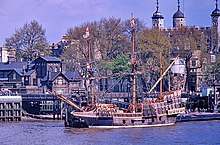
Drake used the simply ways of what the globe looked like and at the time that was from the Flemish cartographer Abraham Ortelius's map Theatrum Orbis Terrarum.[19] Rather than reveal his true intentions, Drake told the crew they were embarking on a trading voyage to Levant. The reason for this was to persuade the men to take ship and to avoid knowing the existent dangers they faced.[20]
| Name | Captain | Crew | Weight (tons) | Fate |
|---|---|---|---|---|
| Pelican (Golden Hind) | Francis Drake | 80 | 160 | Completed voyage |
| Elizabeth | John Wynter | 45 | 80 | Deserted off Cape Horn and returned home. |
| Marigold | John Thomas | 25 | 30 | Lost with all hands off Greatcoat Horn |
| Bridegroom (supply) | Thomas Moon | Exchanged for Christopher | ||
| Swan (supply) | John Chester | scuttled |
Drake and the fleet prepare out from Plymouth on xv November 1577, but presently encountered a storm in the English aqueduct. Attempting to head back to port, they were too belatedly – Pelican and Marigold suffered serious damage to their masts. They were forced to take refuge in Falmouth, from there they returned to Plymouth for repairs which lasted nearly a month.[21]
[edit]
They finally left Plymouth on 13 December heading South into the Atlantic, but poor winds led them to their get-go port of call two weeks later at Mogador off Morocco. Whilst assembling a Pinnace there Drake lost a man to Moorish raiders. Setting off again he sailed past the Canary Islands where the armada captured three Spanish fishing vessels and three Portuguese caravels. The Benedict was swapped for ane of the bigger Spanish vessels; a fifty-ton ship which was renamed Christopher, the Benedict itself was released with the prisoners.[22]
Atlantic crossing [edit]

Scene depicting Francis Drake meeting Native Americans in S America by Theodor de Bry
In January 1578 Drake then set off for the Portuguese Greatcoat Verde Islands hoping for plunder and supplies. Stopping at Santiago island he encountered the Santa Maria, a Spanish merchant ship which he captured despite coming under burn down from a fort's guns just off Praia. The send was loaded with wine and other stores, and was renamed Mary. Drake used the ship's booty of useful Castilian maps just more chiefly added a Portuguese navigator Nuno da Silva, a homo with considerable experience navigating in South American waters and who was willing to help Drake.[14] Drake causeless command of the Mary and reassigned Doughty to command his flagship the Pelican and prepare the captive Spanish crew off in a pinnace. Later tension betwixt Drake and Doughty however turned sour when the latter accused Drake'due south brother, Thomas of stealing from the captured cargo of vino.[22]
During the long voyage across the Atlantic, Drake'southward hostility increased, fuelled by the rancour of his brother. Equally a result, Drake eventually demoted Doughty to command of the Swan. This insult proved as well much for Doughty to have, and he began to complain bitterly near "the Captain General".[23]
Rounding South America [edit]
Afterward passing the declension of Portuguese Brazil, Drake'due south fleet suffered dandy attrition after storms twice scattered the fleet; so on xiii May Drake put in to a bay and anchored off Cape Tres Puntas in the San Jorge Gulf. Another storm blew up and the fleet once again were forced to run for the open sea. When the Swan became separated from the rest of the fleet during a severe tempest, Drake became convinced that Doughty was practising witchcraft and this became somewhat of a bad superstition among the crew.[24]
On 17 May the fleet anchored in Deseado in society for the other ships to catch up, and over the adjacent few days the fleet was brought together except the Swan nether Doughty. They turned upward the following day to encounter a seething Drake where they had another quarrel, the old accusing him of witchcraft which he vehemently denied. Decisions were made regarding the fleet – Drake realised the demand to condense his force due to losses sustained from disease and storms from the Atlantic crossing. The conclusion was made to scuttle Swan – the resultant loss of his command enraged Doughty. He confronted Drake who promptly lost his atmosphere, struck Doughty and ordered him bound to the mast. It was decided that the ex Spanish Christopher was no longer needed and then was burned, and so merely the rigging and ironwork was kept.[25]
Execution of Doughty [edit]
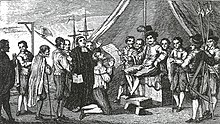
Trial of Thomas Doughty – he would later be executed at San Julian
By 3 June both Doughty and his brother, John who had been defending him had been put under house arrest and the sailors were forbidden from interacting with them. Drake accused Doughty of being "a conjurer and a seditious person", and his brother of being "a witch and a poisoner".[26]
The English made landfall on the bay of San Julian a natural harbour in Patagonia. Ferdinand Magellan had chosen in the aforementioned identify half a century earlier, where he put to death some mutineers. Drake'due south men saw weathered and bleached skeletons on the grim Spanish gibbets and decided to remain in San Julian for the winter before attempting the Strait of Magellan.[27]
Whilst in San Julian Drake finally made the decision to try Doughty with treachery and an incitement to mutiny. The main pieces of evidence confronting Doughty were the testimony of the ship's carpenter, Edward Bright, who after the trial was promoted to chief of the ship Marigold, and Doughty's admission of telling Lord Burghley, a vocal opponent of agitating the Spanish, of the intent of the voyage. Drake consented to his asking of Communion and dined with him along with Francis Fletcher who had this foreign account:
And after this holy repast, they dined also at the same table together, as cheerfully, in sobriety, every bit e'er in their lives they had done aforetime, each cheering upwardly the other, and taking their leave, by drinking each to other, as if some journeying only had been in hand.[28]
The trial eventually found Doughty guilty, merely just on the mutiny charge. On 2 July, at Drake's insistence, Doughty was beheaded, but this stern example did not take the desired effect. Drake held upwards his severed head and stated, 'behold the caput of a traitor'. Increasing tensions between mariners and the gentlemen explorers brought the prospect of wildcat and this would last nearly a month. Drake went one stride farther and used a sermon to make a spoken language laying down rules of conduct, with himself in sole command. The event on the assembled crew was powerful and from then mutiny was never on the heed of anyone.[29]
After attempts to repair Mary information technology was discovered that she had rotting timbers, then they bankrupt up the ship for parts. In August they set off sailing West and and so went on an attempt to laissez passer through the Strait of Magellan.[30]
Strait of Magellan [edit]
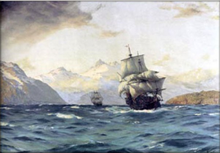
Prior to entering the Strait, in July 1578, Drake sent Wynter ashore where he learned from ethnic people that they ate the astringent bawl Winter'due south bawl.[31] Helm Wynter ordered the collection of bang-up amounts of bark – hence the scientific name.[32] Drake renamed the Pelican as the Golden Hinde on 20 August 1578[33] to honor his patron, Sir Christopher Hatton, whose family crest was a golden hind (female person reddish deer). Drake passed through the Strait of Magellan in just 16 days. Every bit soon as they entered the Pacific Ocean, vehement storms near shattered the remaining ships. The Marigold was lost with all hands and was never to exist seen again. A week later, the Elizabeth became separated from the Gold Hinde and was dilapidated to the signal that the crew demand they head for home. Wynter, hopeful that he would encounter the other ships in plough, demanded that he sheet on to the Eastward Indies and rendezvous with Drake. Fearing an all out mutiny, he reluctantly headed back to England.[34]
The armada now only composed the Golden Hinde with less than half of the 170 men that had ready out. He sailed on to Tierra Del Fuego and arrived at ane of the islands there. In the Magellan Strait Francis and his men engaged in skirmish with local indigenous people, condign the first Europeans to kill indigenous peoples in southern Patagonia.[32]
Subsequently this passage, the Golden Hinde was pushed s and discovered an island which Drake called Elizabeth Island. Drake, like navigators before him, probably reached a latitude of 55°Southward (according to astronomical data quoted in Hakluyt'due south The Principall Navigations, Voiages and Discoveries of the English Nation of 1589) along what is at present the Chilean coast. Despite popular lore, it seems unlikely that he reached Greatcoat Horn or the eponymous Drake Passage, because his descriptions practice not fit the first, and his shipmates denied having seen an open up sea. The first report of his discovery of an open channel south of Tierra del Fuego was written after the 1618 publication of the voyage of Willem Schouten and Jacob le Maire around Cape Horn in 1616.[35]
Mocha Isle and the Mapuche [edit]
The Golden Hinde sailed north along the Pacific coast of S America – his first port of call was Mocha Island to get food and water. They encountered the Native Mapuche and greeted them with pleasantries the feelings of which were mutual. The first twenty-four hour period proved to exist a success with the Mapuches bringing a number of sheep, chickens and wheat to the coiffure. On the second day an 11-man boat came ashore for water but the reception turned hostile; they were set upon and the Mapuche (who were convinced that Drake and his men were their Spanish oppressors)[ commendation needed ] killed two and captured two more. A number were wounded including Diego and Drake who both had a large number of pointer wounds; Drake had ane in the face. They withdrew but according to Fletcher the fate of ii captured was decease in ritual cannibalism being slowly carved into pieces and eaten alive.[16] [36]
Diego never fully recovered from his many wounds. A year after, when the expedition neared the Moluccas, he died, perhaps from a lingering infection. Drake regretted the loss of his retainer and his skill, diplomacy and knowledge of S America.[15]
Raids on Castilian American west coast [edit]
Heading further Northward, Drake recovered from his wounds and spent many weeks observing for settlements to raid.
Valparaíso and Callao [edit]
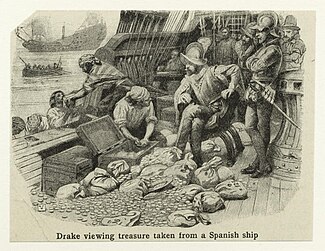
On December five he viewed the modest Castilian settlement of Valparaíso, a coastal town with a number of houses and a church. He made an attack on the town and plundered what he could find, such equally valuable art treasures and the church silverish. Its harbour independent a ship which proved the most valuable as it was total of Chilean wine, 25,000 pesos in gold and with charts of the South American coast.[37] Drake'south sack of Valparaíso gave origin to the legend about Cueva del Pirata.[38]
Drake left and carried on Northwards up the declension. He sailed into the remote Salada Bay near Copiapó where he was able to careen his transport and assembled the Golden Hinde'south pinnace. Whilst here Drake attempted to expect for the Elizabeth to appear which would've given sufficient forcefulness to attack Panama, the next target. When it became apparent that Elizabeth wasn't going to turn upwardly, Drake sailed off once the pinnace had been completed.[39]
Just earlier they got to Callao a Castilian coaster was intercepted and captured; from the prisoners information was gained bearing news that a number of treasure ships were heading in the area. As a upshot, Drake entered Callao which was the harbour for Lima on 13 February. The English took the town with ease and in the harbour lay a dozen vessels which Drake ordered ransacked and run aground. They then questioned the inhabitants from whom they learnt that a large treasure galleon called Nuestra Señora de la Concepción, had recently departed North Due west towards Panama bearing a valuable cargo of silverish with its concluding destination of Manila. The following day an excited Drake rushed off in pursuit with the recently built pinnace and headed to the direction where the Spanish treasure galleon was most likely to be intercepted.[forty]
Spanish pursuit [edit]

Around the aforementioned time the Spanish authorities began getting reports that an English naval force was off the declension. Panic began to spread once news that settlements had been raided. In Lima the Viceroy of Republic of peru Francisco de Toledo was shocked and was surprised that the English language had got this far. He immediately ordered all ships to exist repaired and re floated from Callao to pursue but none were equipped to challenge Golden Hinde. A dispatch was also sent off to Lima calling for more troops, and ii ships were called for the chase. Frias Trejo commanded the Nuestra Señora del Valle and Pedro De Arana in the Nao de Muriles. These ii were however improperly ballasted and so returned to port despite both being in sight of Drake. Toledo furiously ordered his own son Luis to lead the expedition with two heavily armed galleons and eleven other vessels to capture whatsoever English vessel they came across. They also were given the all-time pilots in the region including Pedro Sarmiento de Gamboa and 120 soldiers.[41]
The armada left Callao on 27 February and set out in pursuit of the English language who they idea were heading towards Panama where Gamboa thought Drake would strike next.[42]
Drake still in pursuit of the Nuestra Señora de la Concepción and unaware of the sizeable Spanish strength at present coming for him, took a pocket-size ship just having departed from Guayas River which led to Guayaquil. The transport belonged to Benito Diaz Bravo and in its hold contained nearly 20,000 aureate pesos from the Zaruma gold mines along with other victuals.[43]
Capture of Spanish treasure ships [edit]

On i March Drake sighted the Nuestra Señora de la Concepción just off the Audiencia of Quito coast. Drake came across the slower moving galleon so moved the pinnace towards the Spanish ship's port. The Spanish captain Juan de Anton was surprised to run into a foreign vessel out this far. Drake ordered Diego to demand in Spanish for their sails to strike. Anton however refused and and then Drake answered with cannon and arquebus fire. No further answer came from the Spaniard then more cannons were fired, this time damaging Nuestra Señora de la Concepcióndue south rigging and besides tore the mizzenmast and lateen 1000 off. Then with the Gilded Hind on one side and the pinnace on the other, the English airtight in and were able to board the vessel.[44] Since they were not expecting English ships to be in the Pacific, Nuestra Señora de la Concepciónsouthward (which later become known as Cagafuego 's) crew was taken completely by surprise and surrendered chop-chop and without much resistance. Once in command of the galleon, Drake brought both ships to a secluded stretch of coastline to unload the treasure.[45]
Such was the hoard, it took six days for the treasure to be unloaded. Aboard the Nuestra Señora de la Concepción, Drake discovered 36 kilograms (lxxx lb) or 13 chests full of royals of plate and 26 thousand kilograms (26 long tons) of silvery. 25,000 pesos of amounting in value to 37,000 ducats. In improver a golden crucifix and jewels completed the total worth around 360,000 pesos (about £7m by mod standards). In total the treasure amounted to the equivalent to around £480m in today'southward terms. There was so much treasure that the silver bars replaced the Golden Hinde's anchor.[46] The coiffure could not believe their luck and were overjoyed at the sight of the Spanish galleon'due south treasure, and their morale reached a new loftier. Drake was as well pleased at his good luck, and he showed information technology by dining with Cagafuego 's officers and admirer passengers. He offloaded his captives a short time afterward, and gave each 1 gifts appropriate to their rank, as well every bit a letter of the alphabet of safe behave. Through Diego, Drake was able to barefaced the Spanish and fabricated it clear that in that location were other English ships in the surface area such as the Elizabeth under John Wynter (even though he had returned abode) in order to cause some kind of panic and defoliation and lead the Spanish into a wild-goose chase.[45]
On 16 March Luis de Toldeo and Gamboa sailed into Manta to get together any information they could get on Drake. They were told about Drake's pursuit of the Nuestra Señora de la Concepción and information technology was soon realised the inevitability that Drake had captured the send. Gamboa yet had a plan that if Drake was loaded with treasure, he would be able cut him off before he would get to the coast of the Province of Nicaragua. Don Luis all the same proposed to become to Panama in order to carry on his voyage and deliver his father's vital report regarding the English discovery of the Spanish settlements in South America.[47]
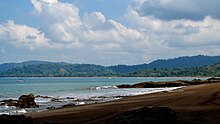
Meanwhile, Drake went farther north along the South American declension. Coming across Cano isle Drake captured a frigate conveying a cargo of maize, honey and sarsaparilla. Drake took the vessel to a nearby bay (Bahía Drake); hither the Aureate Hinde was repaired and careened. Drake decided that the enormous haul of treasure in the Golden Hinde needed to exist transferred to lighten his send if he was to carry on any further. At the isle they moved part of the silver over to the captured frigate which proved a sturdy ship. The frigate was also armed by a number of the Gilt Hindes' guns.[48] Drake sent a party with the pinnace to forage and refill their water casks. Equally they moved into the dense tropical rain forest they managed to kill a crocodile and a monkey which they brought back to the ships. This was the showtime fourth dimension they had tasted meat for some fourth dimension. At the aforementioned time the English felt a 'severe shake' despite being a mile offshore – it was in fact their first feel of a violent earthquake – and some of the crew even witnessed what was a tsunami on the nearby shore.[49]
Whilst the Gilded Hinde was being repaired, the pinnace was scouting the area and came beyond another Spanish vessel which was before long captured with only a shot fired – this time a small barque. Although there was little value in the hold, the English did capture two valuable rutters which showed in detail the Manilla-Acapulco route. Likewise on board were ii Chinese pilots who knew the road beyond the Pacific. Drake and then disposed of the Sarsaparilla (the crew reported this as being an 'unpleasant scent'), and set off in the last week of March intending to raid the boondocks of Guatulco.[48]
Last raids [edit]
Drake and so raided the settlements of El Realejo and Sonsonate finding little of value.[50] At Guatulco the English language went ashore against lilliputian resistance and promptly sacked the place. The haul was considerable; a heavy aureate concatenation along with 7,000 pesos in silver was looted. In that location were plenty of provisions like water casks and nutrient which the crew desperately needed but as well fine Mainland china and silks, more maps of the Manilla galleon route and a number of slaves. Drake stayed for a couple of days, post-obit which he released all the Spanish captives. The Portuguese airplane pilot Nuno da Silva was also released here; he had gone beyond his usefulness having little to no knowledge beyond the Magellan straits.[51] He was also told that he was to give imitation information to the Castilian in a double barefaced in that Drake had intended to go home via the Northwest Passage. Guatulco would evidence to be Drake's final raid on the West Declension of New Spain.[52]
Nuno da Silva was later questioned by the Spanish in regards to Drake'south whereabouts – he was tortured and interrogated, giving the information that Drake wanted them to hear, in that he was heading for the Northwest passage. The Castilian however did non believe this as Drake had really hoped. At the same time the Spanish pursuit was going nowhere, having caught no sight of any English ships.[52] In the end Toledo had no existent desire to overtake Drake who they thought must exist much further Due north. Toledo proceeded to Panama where the 'pursuit' ended. Yet, the Spanish continued to baby-sit the routes where they thought Drake would plough around to head back via the Straits of Magellan.[19]
California and Pacific North West [edit]
Drake sailed north to seek a shortcut back to England via the hypothetical Strait of Anián, a supposedly navigable shortcut connecting the Pacific and Atlantic. The strait was speculated to exist at near 40 degrees n.[53]
In May Drake's two ships passed the Baja Peninsula and connected North. Prior to Drake's voyage, the western coast of Due north America had just been partially explored in 1542 by the Spanish explorer Juan Rodriguez Cabrillo. Intending to avoid further disharmonize with Kingdom of spain, Drake navigated northwest of Spanish presence. By navigating well beyond where Cabrillo had asserted Spanish claim in the Pacific Northwest, Drake searched for a suitable bay to repair and careen his send for the journey back to England.[21]
On 5 June 1579, the send briefly fabricated kickoff landfall at Due south Cove, just south of Coos Bay or at Whale Cove almost Depoe Bay and gathered fresh water and food. Although Drake may have possibly reached a breadth as high as 48 degrees, his northward progress was ultimately stopped by foul weather in the northeast trade winds chugalug. Upon failing to locate the strait, Drake went no further Due north and instead headed back south.[54]
Nova Albion [edit]
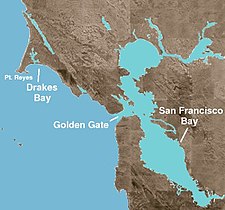
On 17 June, as Drake headed South, his crew found a protected cove and landed on the coast of what is at present Northern California. Afterwards staying there for twelve days Drake fix off again and landed somewhere north of Spain'due south northernmost merits at Indicate Loma, in Alta California. He found a practiced bay and landed in an estuary which became known equally Drakes Estero. Afterward erecting a small wooden fort and tents ashore, the crew restocked the ii ships then stayed for a time to repair and careen the 2 ships.[55]
Drake also met the Native Coast Miwok people and soon had friendly interactions with them exchanging gifts while the English were given nutrient.[56] In a particularly significant gesture, a big assembly of Coast Miwok descended on the encampment and honoured Drake by placing chains around his neck, a sceptre in his paw, and a crown of feathers on his caput as if he were being proclaimed king. Upon this uncertain, seemingly voluntary surrender of sovereignty by its owners, England based its presumed legal authorization to the territory.[57] Drake thus claimed the land in the name of the Holy Trinity for the English Crown as chosen Nova Albion – Latin for "New Great britain" and for Queen Elizabeth I. Drake chose this particular proper noun for 2 reasons: outset, the white banks and cliffs which he saw were similar to those constitute on the English Aqueduct declension and, 2d considering Albion was an archaic name by which the island of Great Great britain was known. To document and affirm his claim, Drake is said to accept an engraved Drake's Plate of Brass, 1 which contained a sixpence bearing Elizabeth'south paradigm, attached to a large post. Giving details of Drake's visit, information technology claimed sovereignty for Elizabeth and every successive English monarch.[58]
After gaining the Coast Miwok's trust, Drake journeyed to explore the inland area and visit their villages. Accompanied with crew members, Drake trekked on a Declension Miwok trail to traverse the Inverness Ridge and descend into what is now the Olema Valley.[55] Francis Fletcher observed and wrote in detail regarding the wildlife, countryside and climate. He wrote in bully detail on the Coast Miwoks themselves in day-to-day activities beingness the first person to make a written record of any of the 64 distinct language groups in prehistoric California.[59]
After staying on this particular stretch of coast for several weeks the English were ready for the return voyage, and decided to go out the Castilian frigate behind in the bay. Overall, the relations between the Coast Miwok and their visitors were peaceful and friendly. When Drake and the crew left New Albion on 23 July, the Miwok seemed to exhibit distress when Golden Hinde sailed away.[60]
Drake paused his journey the side by side day when anchoring his ship at the Farallon Islands where the crew hunted seal meat.[61] Assertions that he left some of his men behind as an embryo "colony" are founded on the reduced number who were with him in the E Indies.[62]
-
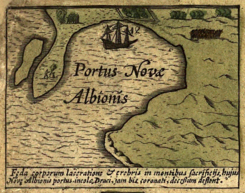
Particular of Jodocus Hondius map of 1589 showing cove in New Albion visited by Francis Drake.
-
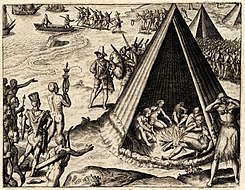
Drake's landing in California, engraving published 1590 by Theodor de Bry
-
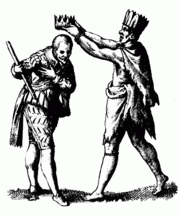
Natives of California greet Sir Francis Drake
Pacific and E Indies [edit]
On July 23 the Golden Hinde left New Albion and two days later they sailed west to keep their Pacific crossing.[lx] Winds were good enough to carry the ship roughly S Due west to the Caroline Islands past xiii October; an unusually very quick passage at the fourth dimension.[63] After staying at either Yap or Palau for 2 days they were met with some hostility from the natives who came in canoes in the hundreds. This led to some problem and fearing existence overwhelmed the English fired a number rounds killing or wounding some twenty before sailing off.[64]
A week later on the encounter a Portuguese carrack was sighted. Drake intended to capture the vessel then a running boxing ensued until the carrack moved in amidst some shoals. Drake with his send heavily laden with goods dared not enter for fearfulness of running aground and then veered off continuing Westwards.[65]
Moluccas and Celebes [edit]
Drake having sailed past Mindanao presently reached the Moluccas. These were a group of islands in the south w Pacific known as the 'Spice Islands' for its rich plantations of nutmeg and cloves. Drake was cautious most meeting further Portuguese trading settlements, but he was in luck – by mid 1575 most of the Portuguese positions in the Moluccas had already fallen to the natives of the islands. In addition the indigenous tribes or kingdoms that had supported the Portuguese had been virtually cornered.[60]

Impress showing Francis Drake in Ternate meeting the Sultan, Babullah in 1579
In early on November 1579 having passed Siau Island Drake encountered ii fishing canoes who were able to guide the Golden Hinde through the islands. They led him to the island of Ternate – its volcanic summit Gamalama dominating the skyline. There Drake was able to dock and the crew were warmly welcomed past Sultan Babullah in a civil courtesy in an old Portuguese castle. The Sultan controlled a number of other islands in improver to Ternate and traded more often than not in cloves. Drake proclaimed himself no friend of the Portuguese and expressed an interest in trading for spices.[64]
Later on the showtime circular of negotiations, Babullah sent a sumptuous repast to Drake and his men: rice, chicken, sugarcane, liquid sugar, fruit, coconuts and sago. Drake was impressed with Babullah, noting the enormous respect that he enjoyed from his subjects simply could not fulfil on any agreements. In particular he resisted invitations to join in a entrada against the last remaining Portuguese fort in Tidore since his mission was to go dorsum to England equally soon every bit possible and fulfil his mission. With English linen, gilt and silver, Drake was able to trade for around x tonnes of exotic spices – most of these were cloves simply included ginger, black pepper and nutmeg. With so many cloves on lath that were worth so much – Drake rewarded his crew with silvery which boosted their morale. The Gilded Hind stayed for a further five days earlier sailing away.[66]
Drake sought a place to trim and water his ship and presently arrived off the Celebes islands unaware of the unsafe shoals and subsequently became caught on a reef on 8 January 1580.[67] Here Fletcher came at odds with Drake – in a sermon he preached regarding the grounding, Fletcher suggested that their ships' recent woe had resulted from the execution of Doughty which Drake promptly claimed as unjust. After the sermon, Drake had Fletcher chained to a hatch cover, then "solemnly excommunicated him".[68] The sailors waited for expedient tides and soon dumped iii tons of cargo (mostly cloves) and a number of guns – this eventually freed the ship afterwards iii days much to the crew'south and Drake'southward relief. Equally they left they were driven westwards into the Banda Bounding main and refitted at either Damer or Romang island to trim and careen Golden Hinde.[69]
Java [edit]
The next month was frustrating for Drake – bad weather and confusing seas of the East Indies meant going was tough. They slowly made their mode into the Samu bounding main Westwards passing the Northern declension of Timor. On March xi they somewhen touched downwards at Tjilatjap on Coffee having anchored a rubber distance from land. A boat load of armed men came ashore and were well received by the locals who showed them where to find water and nutrient. Following this Drake and then made contact with the rajahs and presently began exchanging courtesies and commodities.[70] The latter simply wanted the finest silks and of which Drake had enough from what they had taken at Guatulco. They stayed for two weeks and gathered plenty supplies namely rice, chickens, yams and dried beef for part of the journey back.[71] Although the Portuguese were familiar with Java'due south northern coastline and suspected that it was an isle, Drake was the first European to navigate the southern shores and to prove that Java was not part of the continent of Terra Australis.[69]
On 24 March Drake sailed off and defenseless a skillful air current, and next entered the Indian Ocean; he had roughly 11,000 miles to go before he reached England.[72]
Indian Sea to Plymouth [edit]
Drake had a good wind and without stopping eventually came across the Southern tip of Africa. They rounded the Cape of Good Hope on June 15 where they feared severe storms after reading from accounts by Portuguese and Spanish sailors merely were surprised on encountering good weather and a decent current of air. Sailing North, food and water became desperately short after having sailed well-nigh 9,700 miles without stopping and with but ane homo lost.[73] As they continued Due north they reached the Western tip of West Africa (present 24-hour interval Sierra Leone) and landed on 22 July taking on fresh water, fruit and provisions. For near all of the crew they encountered elephants for the beginning fourth dimension and an 'oyster-tree', which had no leaves on it, but multitudes of oysters. They were also able to repair the ship, and in one case done left ii days later heading for the English Channel.[74]
Although they were budgeted England there was concerns for Drake and the crew on their render since they had left – these were that Rex Philip of Espana might accept had declared war equally a result of Drake's actions. Or that Elizabeth had been removed from the throne either by expiry or rebellion and that Mary Queen of Scots may be the new Queen. Drake was to make sure he encountered English merchant vessels to gather information before he finally entered port.[69]
Drake arrived in the English Channel on 26 September, and presently came across some fishermen. He asked questions such as, who was on the throne and were England at peace.[73] The fishermen informed them that all was well, but they were astonished to find that information technology was Drake. By this time, most in England had presumed him and his men all to be lost when John Wynter who had returned alone with the Elizabeth a twelvemonth previously. The fishermen sailed into Plymouth with Drake and 59 remaining coiffure aboard, along with the rich cargo of spices and captured Spanish treasures.[75]

Map showing Drake'south circumnavigation around the globe
Aftermath [edit]
Drake not just became the first Englishman to circumnavigate the globe, he was too the first to complete a circumnavigation as a captain while leading the expedition throughout the entire voyage.[vi] Drake withal was not the first Englishman to canvas the Pacific Ocean; this fell to Magellan's mastergunner during the 1519 expedition.[76]
Drake ended up having raided or plundered six coastal towns; he took thirteen ships, plundered them, used them and either released or scuttled them. He ran aground another twelve in Callao.
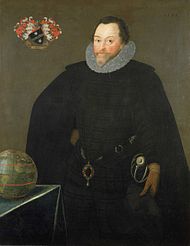
1591 portrait, also past Gheeraerts the Younger, celebrates his circumnavigation of the globe. He wears the Drake Precious stone suspended from a strap, and displaying new arms

Elizabeth awarded Drake a knighthood aboard Golden Hind in Deptford on iv April 1581; the dubbing being performed by a French diplomat, Monsieur de Marchaumont, who was negotiating for Elizabeth to marry the King of France's brother, Francis, Duke of Anjou. By getting the French diplomat involved in the knighting, Elizabeth was gaining the implicit political support of the French for Drake'due south actions.[77] After receiving his knighthood Drake unilaterally adopted the armorials of the ancient Devon family of Drake of Ash, near Musbury.[78]
The venture raised an enormous amount of money for the nation'south coffers. As a result, the Queen declared that all written accounts of Drake'southward voyages were to get the 'Queen's secrets of the Realm'. In addition Drake and the other participants of his voyages were sworn to their secrecy on the hurting of decease; she intended to keep Drake's activities away from the eyes of rival Spain. Drake presented the Queen with a jewel token commemorating the circumnavigation. Taken from the Nuestra de La Concepetion, it was made of enamelled aureate and bore an African diamond and a ship with an ebony hull. For her role, the Queen gave Drake a jewel with her portrait, an unusual gift to bestow upon a commoner, and one that Drake sported proudly in his 1591 portrait past Marcus Gheeraerts now at the National Maritime Museum, Greenwich. The "Drake Jewel", every bit it is known today, is a rare documented survivor amid sixteenth-century jewels; it is conserved at the Victoria and Albert Museum in London.[79] Equally for the rewards, all investors which included Walsingham were rewarded handsomely as individuals who received a return of some 5000 per cent. Some of these men invested in the Levant Company and this led to overseas merchandise expanding abroad from the Iberian controlled Indies.[73]
Drake became incredibly rich, and was also allowed to keep £24,000 of the purloined treasure for himself and his coiffure.[80] He was admired and celebrated by many in England, and became politically powerful – equally well as being knighted he quickly became a favourite at the Queens's court. Drake became Mayor of Plymouth in September 1581 and so went on to get a fellow member of parliament in 1581 and 1584. The execution of Doughty yet continued to haunt Drake afterwards. John Doughty, sought legal recourse over the execution of his brother, just the action was dismissed on a technicality.[81]
Drake also had the Queen'south approval to continue his entrada of privateering and the money raised from these raids helped fund the second half of Elizabeth'due south reign. The Crown lacked sufficient funds to build an efficient navy, but privateering helped subsidised state power past mobilising armed ships and sailors.[82]
The circumnavigation was as well a phenomenal propaganda success that had lasting consequences. The personal stories of the seamen surviving the uncharted perilous waters of the unknown world and the lure of such adventures was an of import element in the eastern blueprint in the tardily sixteenth century. Thomas Cavendish straight influenced past Drake's voyage gear up out in 1586 and completed his circumnavigation by 1588. Then other voyages of exploration followed – Ralph Fitch attempted an overland voyage 3 years after Drake'southward return, Walter Raleigh in 1595 and James Lancaster in 1591 and 1600 – the latter of whom was one of the founders of the East India Company.[83] Thus began a menstruation of British maritime and colonial potency that lasted until the 20th century.[84]
Spanish reaction [edit]

After Drake'southward successful voyage, the Spanish now felt vulnerable in their colonies. Francisco de Toledo realised the weakness and wanted to build a serial of fortifications on the coast for protection against strange pirates. He also established 'la Armada del Mar del Sur' (the Southern Armada) in the port of El Callao.[85] The bulk of investment withal was for defences and look outs in the Strait of Magellan. In social club to seal the passage and having feared they were nether English command, Toledo sent a squadron with two ships under Pedro Sarmiento de Gamboa not only to explore but as well accept the region every bit a possession for Spain. They scrupulously explored the strait, trying to catch out any English they idea were hiding, though none were there. They likewise surveyed where to build fortifications. Gamboa so direct proceeded to Espana to inform Philip II of the dangers of a seaway open to his European enemies. Once this has been done, approval was given for remedial action and in 1584 an expedition was launched. This however achieved very lilliputian, two settlements including Ciudad del Rey Don Felipe were doomed to failure. Gamboa was captured past English language privateers two years later.[86]
The biggest repercussion from the voyage all the same was the relationship between Kingdom of spain and Portugal; the capture of the Neustra de la Formulation by Drake proved a stupor as it provided evidence that the Castilian had been active in the Far East which had already been a Portuguese concession from the Pope as stated in the 1494 Tordesillas treaty. Every bit a issue, this which became one of the reasons for Philip to launch a Spanish invasion of Portugal which led to the Iberian Union.[14]
Drake's 2 expeditions had increased the annoyance of Philip Two, and Anglo-Castilian relations connected to deteriorate, eventually moving towards open state of war.[two]
War [edit]
War between England and Espana officially began in 1585 shortly later the execution of Mary Queen of Scots and English involvement in the Dutch Defection. The Queen ordered Drake to lead the adjacent trek to attack the Spanish New World in a kind of preemptive strike. Drake sailed to the West Indies and in 1586 captured Santo Domingo, Cartagena de Indias and raided St. Augustine. News of this reached Spain and this at present further buoyed an invasion of England past Philip.[87]
Philip'southward project to send an invasion 'Fleet' confronting England soon became known; Drake was to pb withal another preemptive strike on Castilian ships being prepared for it in Cadiz in April 1587. A number were destroyed and the raid, which Drake described as his 'Singeing the King of Spain'south Beard' delayed the Armada for a year. This immune the English to mobilise their defense and Drake was also a leading player during the Armada campaign. Drake's power to assail England'southward Cosmic enemies made him a hero at abode and the terror of the Spanish, who chosen him 'El Draque' (The Dragon). King Philip put a cost some 20,000 ducats for anyone who could eliminate Drake.[88]
Nova Albion claim [edit]
The precise location of the port in Nova Albion was carefully guarded to keep information technology hush-hush from the Spaniards, and several of Drake's maps may have been altered to this finish. All showtime-mitt records from the voyage, including logs, paintings and charts, were lost when Whitehall Palace burned in 1698. A statuary plaque inscribed with Drake'southward claim to the new lands – Drake's Plate of Contumely – plumbing fixtures the description in his business relationship, was discovered in Marin County, California just was later declared a hoax. Now a National Historic Landmark, the officially recognised location of Drake'southward New Albion is Drakes Bay, California.[89] Some writers have suggested that Queen Elizabeth'south desire to maintain secrecy of the locations and extent of Drake's north Pacific explorations led to suppression and obfuscation of the reports.[90] Yet, many of historians, geographers, linguists, anthropologists and other professionals have put forward their ideas of where Drake landed covering the coast from Alaska to northern Mexico.
The claim of Nova Albion occupied a pregnant place in British geopolitical considerations for centuries and even strengthened Britain's entitlement to the fur trade commerce along the Northwest Coast. Its influential assertions came in the Nootka Crunch with Spain in 1789 and besides negotiated the 1846 Oregon Treaty which extended the border of Canada along the 49th parallel to the Pacific.[91]
Legacy [edit]
The voyage intrigued the likes of Gerardus Mercator who was often in contact with Abraham Ortelius regarding Drake's discovery of 'Nova Albion', although it was frustrating for them both given the secrecy of Drake'south voyage.[73]
The earliest detailed business relationship of the voyage was The Globe Encompassed by Sir Francis Drake,[92] published in 1628, which was compiled by Drake's Nephew, based on his uncle'due south journal, the notes of Francis Fletcher, and other sources.[93] Nineteenth-century historians had to rely on the vague accounts supplied by Drake's navigator, Nuna da Silva, to the Spanish Viceroy in 1579, and past John Wynter, to the British navy. It was only in 1909 that da Silva'due south detailed log was discovered in the archives of Seville by Zelia Nuttall.[94] This log gave historians the best insight into Drake's voyage and likewise what life was like in the Elizabethan Navy.[73]
With the 400th anniversary of the circumnavigation, a replica of the Gold Hinde was built starting in 1973. It sailed from Plymouth on her maiden voyage in late the post-obit yr, arriving on 8May 1975 in San Francisco, to commemorate Sir Francis Drake's claiming of New Albion in California.[95]
-

Drake receives knighthood from Queen Elizabeth. Bronze plaque by Joseph Boehm, 1883, base of Drake statue, Tavistock
-

Statue commemorating Drake and his circumnavigation of the World in Plymouth Hoe
-
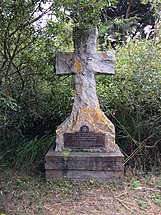
Cantankerous commemorating the landing of Drake, in California in June 1579
-
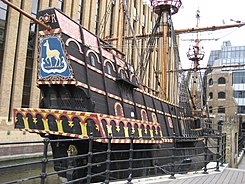
The stern of the "Gilded Hinde" replica docked in Southwark
In popular civilization [edit]
The circumnavigation was depicted along with the replica of the Gold Hinde in the 1980 flick Drake's Venture.
Run across also [edit]
- Magellan's circumnavigation
- Loaísa trek
- Martín Ignacio de Loyola
- George Anson's voyage around the earth
- Operation Drake
- Drimys winteri
- A Strange Discovery
References [edit]
- Citations
- ^ Lane & Bialuschewski 2019, p. 21
- ^ a b Wagner 2013, p. 87
- ^ Lytle Schurz, William (1922), "The Spanish Lake", The Hispanic American Historical Review, v (ii): 181–194, doi:10.1215/00182168-5.two.181, JSTOR 2506024
- ^ "Navegantes europeos en el estrecho de Magallanes [Discovery and recognition of the territory: European navigators in the Strait of Magellan]". Memoria Chilena (in Spanish). Retrieved October 20, 2019.
- ^ Soto Rodríguez, José Antonio (2006). "La defensa hispana del Reino de Chile" (PDF). Tiempo y Espacio (in Castilian). 16 . Retrieved 30 January 2016.
- ^ a b Beding 2016, p. 264
- ^ Loades 2003, p. 1147
- ^ Bown 2012, pp. iii–5
- ^ Dean 2013, p. 42
- ^ Williams, Neville (1975). The Sea Dogs: Privateers, Plunder and Piracy in the Elizabethan Age. Weidenfeld and Nicolson. p. 116. ISBN9780297770114.
- ^ Kelsey 2000, p. 66
- ^ Bicheno 2012, p. 133
- ^ Clarke, Benjamin (1852). The British gazetteer: political, commercial, ecclesiastical, and historical; showing the distances of each identify from London and Derby. London: Published (for the proprietors) by H.G. Collins. p. 40.
Vice-Admiral Sir John Wynter knighted by queen elizabeth
- ^ a b c Lindsay 2014, p. 17
- ^ a b Guasco 2014, p. 98
- ^ a b Kaufmann, Miranda. "The Untold Story of How an Escaped Slave Helped Sir Francis Drake Circumnavigate the Earth". History . Retrieved 12 May 2020.
- ^ Sugden 2012, p. 61
- ^ Bicheno 2012, pp. 136–37
- ^ a b Childs 2009, p. 155
- ^ Southwest Pamphlets. 1784. p. 498.
- ^ a b Sugden 2012, p. 130
- ^ a b Bicheno 2012, pp. 138–139
- ^ Kelsey 2000, pp. 97–98
- ^ Poole, Reginald Lane; Hunt, William, eds. (1911). The Political History of England: The history of England from the accession of Edward Vi to the death of Elizabeth, 1547–1603. Longmans, Green & Visitor. p. 319.
- ^ Purves, David Laing (1874). The English language Circumnavigators: The Most Remarkable Voyages Round the World by English language Sailors. William P. Nimmo. p. 53.
- ^ Kelsey 2000, p. 104
- ^ Benson 2015, p. 127
- ^ Barrow, John (1843). The Life, Voyages, and Exploits of Admiral Sir Francis Drake. J. Murray. p. 102. Retrieved 20 June 2020.
- ^ Bicheno 2012, pp. 141–142
- ^ Flanagan 2017, p. 94
- ^ Lynch, Robert G.; Spivak, Samuel (2017). Two Voyages to the Pacific Coast of North America: Francis Drake and Brune de Hezeta, Their Voyages Compared with Information about Scurvy. San Francisco: Drake Navigators Guild. p. 37.
- ^ a b Martinic, Mateo (1977). Historia del Estrecho de Magallanes (in Spanish). Santiago: Andrés Bello. pp. 67–68.
- ^ "Sir Francis Drake: A Pictorial Biography by Hans P. Kraus". Library of Congress . Retrieved 24 March 2017.
- ^ Coote 2005, p. 144
- ^ Kelsey 2000, p. 135
- ^ Mitchell 1981, p. fourscore
- ^ Sugden 2012, p. 125
- ^ Montecino Aguirre, Sonia (2015). Mitos de Chile: Enciclopedia de seres, apariciones y encantos (in Castilian). Catalonia. pp. 196–197. ISBN978-956-324-375-8.
- ^ Spate 2004, p. 251
- ^ Marley 2008, p. 64
- ^ Sugden 2012, p. 126
- ^ Bicheno 2012, p. 144
- ^ Bawlf 2009, p. 141
- ^ Levine & Lane 2015, p. 39
- ^ a b Coote 2005, p. 157
- ^ Bicheno 2012, p. 146
- ^ Bawlf 2009, pp. 146–147
- ^ a b Benson 2015, pp. 154–55
- ^ Bundschuh & Alvarado 2012, p. 1257
- ^ Wycherley, George (1935). Buccaneers of the Pacific Book ane. Rich & Cowan. p. 41.
- ^ Spain in the West, Book 9. A. H. Clark Visitor. 1963. pp. 135–136.
- ^ a b Levine & Lane 2015, p. 42
- ^ Sugden 2012, p. 132
- ^ Bawlf 2009, pp. 360–361
- ^ a b Sugden 2012, p. 135
- ^ Cassels 2003, pp. 263–264
- ^ Wilson 1998, p. 160
- ^ Fletcher, Francis (1854). The world encompassed by sir Francis Drake, beingness his side by side voyage to that to Nombre de Dios. Hakluyt society. pp. 224–225.
- ^ Foster, George McClelland; Beals, Ralph Leon; Heizer, Robert Fleming; Goldschmidt, Walter Rochs (1945). Francis Drake and the California Indians, 1579. Academy of California Press. p. 12.
- ^ a b c Sugden 2012, pp. 138–139
- ^ Thrower 1984, p. 61
- ^ Dismissed by John Cummins, Francis Drake: The Lives of a Hero 1997:118: "In view of the prominence given in different versions to the crowning of Drake information technology would exist odd if the establishment of a colony had gone unrecorded."
- ^ Levine & Lane 2015, p. 43
- ^ a b Thrower 1984, pp. 69–70
- ^ Bawlf 2009, pp. 66, 69
- ^ Mason 2018, p. 157
- ^ Andrews 1984, p. 158
- ^ Oakeshott 2010, p. 83
- ^ a b c Sugden 2012, p. 143
- ^ Wilson 1998, pp. 185–186
- ^ Bicheno 2012, p. 151
- ^ Crompton & Goetzmann 2009, pp. 66–67
- ^ a b c d e Childs 2009, p. 156
- ^ Benson 2015, pp. 169–170
- ^ Thrower 1984, p. 84
- ^ Sugden 2012, p. 94.
- ^ Perry 1996, p. 182
- ^ Drake, H H. "Drake – The arms of his family and surname: Silver, a waver-dragon gules". GENUKI.
- ^ "The Drake Jewel". Oieahc.wm.edu. Retrieved 2010-02-25 .
- ^ Sugden 2012, p. 149
- ^ Senior, W (1921). "Drake at the Adapt of John Doughty". Mariner'southward Mirror. 7 (ten): 295. doi:x.1080/00253359.1921.10655051.
- ^ "Queen Elizabeth I's Body of water Dogs". The History Printing . Retrieved 17 June 2020.
- ^ Lawson 2014, p. 2
- ^ Sugden 2012, p. 151
- ^ Zavala, Silvio Arturo, ed. (1975). "Revista de Historia de América" (79–80). Instituto Panamericano de Geografía eastward Historia: 77.
- ^ Bradley 2009, p. xiii
- ^ Konstam 2011, pp. 76–77
- ^ Hoffman 1999, p. 1
- ^ "Drake Navigator'due south Guild". Drakenavigatorsguild.org. 2012-10-17. Retrieved 2012-10-25 .
- ^ Ward, Robert (July 1981). "Drake and the Oregon coast: Disputed place in USA". Geographical. Royal Geographical Society. LIII (10): 650.
- ^ Spate 2004, p. 58
- ^ "The Earth Encompassed by Sir Francis Drake, Being His Next Voyage to That to Nombre de Dios Formerly Imprinted: Carefully Nerveless out of the Notes of Master Francis Fletcher, Preacher in This Imployment". www.wdl.org. 1628. Retrieved 2020-10-07 .
- ^ "The Earth Encompassed by Sir Francis Drake" (PDF). National Humanities Centre.
- ^ Wilson, Derek A. (1977). The world encompassed: Francis Drake and his great voyage . Harper & Row. pp. 212–215. ISBN9780060146795.
There has always been some defoliation about the movements of Drake's ships during the storms of September and October 1578.
- ^ (AP) (10 May 1975). "S.F. Hails Golden Hinde". Spokane Daily Chronicle. Retrieved 27 Dec 2015.
Bibliography [edit]
- Andrews, Kenneth (1984). Merchandise, Plunder and Settlement: Maritime Enterprise and the Genesis of the British Empire, 1480–1630. Cambridge University Press. ISBN9780521276986.
- Bawlf, Samuel (2009). The Hugger-mugger Voyage of Sir Francis Drake. D & 1000 Publishers. ISBN9781926706245.
- Beding, Silvio A, ed. (2016). The Christopher Columbus Encyclopedia. Beding Springer. ISBN9781349125739.
- Bicheno, Hugh (2012). Elizabeth's Bounding main Dogs: How England'southward Mariners Became the Scourge of the Seas. Conway. ISBN9781844861743.
- Bown, Stephen R. (2012). 1494: How a Family Feud in Medieval Kingdom of spain Divided the Earth in Half. St. Martin's Press. ISBN9781429941303.
- Bradley, Peter (2009). Spain and the Defence of Republic of peru, 1579–1700. Bradley. ISBN9781409297123.
- Benson, E.F (2015). Sir Francis Drake. Books on Demand. ISBN9783734004797.
- Bundschuh, Jochen; Alvarado, Guillermo E, eds. (2012). Central America, Two Volume Set: Geology, Resources and Hazards. CRC Press. ISBN9780203947043.
- Childs, David (2009). Tudor Sea Power: The Foundation of Greatness. Seaforth Publishing. ISBN9781848320314.
- Coote, Stephen (2005). Drake: The Life and Legend of an Elizabethan Hero. New York: Thomas Dunne Books. ISBN9780743468701.
- Crompton, Samuel Willard; Goetzmann, William H (2009). Francis Drake and the Oceans of the World Explorers of New Lands Series. Infobase Publishing. ISBN9781438102474.
- Dean, James Seay (2013). Tropics Bound: Elizabeth's Seadogs on the Castilian Main. History Press. ISBN9780752496689.
- Flanagan, Adrian (2017). The Cape Horners' Club: Tales of Triumph and Disaster at the World's Most Feared Cape. Bloomsbury Publishing. ISBN9781472912541.
- Guasco, Michael (2014). Slaves and Englishmen: Human being Bondage in the Early Modern Atlantic World. University of Pennsylvania Press. ISBN9780812245783.
- Hoffman, Paul E (1999). The Spanish Crown and the Defence of the Caribbean, 1535–1585: Precedent, Patrimonialism, and Royal Parsimony. LSU Press. ISBN9780807124277.
- Kaufmann, Miranda (2017). Black Tudors: The Untold Story. Oneworld Publications. ISBN9781786071859.
- Kelsey, Harry (2000). Sir Francis Drake: The Queen'southward Pirate. Yale University Press. ISBN9780300084634.
- Konstam, Angus (2011). The Peachy Expedition: Sir Francis Drake on the Spanish Main – 1585–86 (Raid). Osprey. ISBN9781849082457.
- Lane, Kris; Bialuschewski, Arne, eds. (2019). Piracy in the Early Modernistic Era: An Anthology of Sources. Hackett Publishing. ISBN9781624668265.
- Lawson, Philip (2014). The East Republic of india Company: A History Studies In Modern History. Routledge. ISBN9781317897651.
- Levine, Robert M; Lane, Kris (2015). Pillaging the Empire: Global Piracy on the High Seas, 1500–1750. Routledge. ISBN9781317524465.
- Loades, D. One thousand (2003). Reader'due south Guide to British History, Book ii. Fitzroy Dearborn. ISBN9781579582425.
- Lindsay, Ivan (2014). The History of Loot and Stolen Art: from Antiquity until the Present Day. Andrews UK Limited. ISBN9781906509569.
- Marley, David (2008). Wars of the Americas: A Chronology of Armed Conflict in the Western Hemisphere. ABC CLIO. ISBN9781598841008.
- Mason, A. E. West (2018). The Life of Francis Drake. Pickle Partners Publishing. ISBN9781789125771.
- Mitchell, Andrew Westward, ed. (1981). Operation Drake, Voyage of Discovery. Severn Firm. ISBN9780727820075.
- Oakeshott, Walter (2010). Founded Upon the Seas: A Narrative of Some English language Maritime and Overseas Enterprises During the Period 1550 to 1616. Cambridge Academy Press. ISBN9781108013420.
- Perry, Maria (1996). The Discussion of a Prince: A Life of Elizabeth I from Contemporary Documents. Boydell Press. ISBN9780851156330.
- Spate, Oskar Hermann Khristian (2004). The Castilian Lake. Volume one of Pacific since Magellan. ANU E Press. ISBN9781920942168.
- Sugden, John (2012). Sir Francis Drake. Random House. ISBN9781448129508.
- Thrower, Norman Joseph William (1984). Sir Francis Drake and the Famous Voyage, 1577–1580: Essays Commemorating the Quadricentennial of Drake'due south Circumnavigation of the Earth. University of California Press. ISBN9780520048768.
- Wagner, John (2013). Historical Dictionary of the Elizabethan Globe: Britain, Ireland, Europe and America. Routledge. ISBN9781136597619.
- Wilson, Derek (1998). The Globe Encompassed: Drake'due south Great Voyage 1577–1580 Drake'southward Cracking Voyage 1577–1580. Allison & Busby. ISBN9780749003227.
Journals [edit]
- Cassels, Sir Simon (August 2003). "Where Did Drake Careen The Gilded Hind in June/July 1579? A Mariner's Cess". The Mariner's Mirror. 89 (1): 260–271. doi:10.1080/00253359.2003.10659292. S2CID 161710358.
External links [edit]
- "Queen Elizabeth I's Sea Dogs". History Press. Macmillian Distribution.
Source: https://en.wikipedia.org/wiki/Francis_Drake%27s_circumnavigation
0 Response to "What Country Had the First Sailor to Circumnavigate the Globe to Avoid Being Caught for Piracy?"
Post a Comment